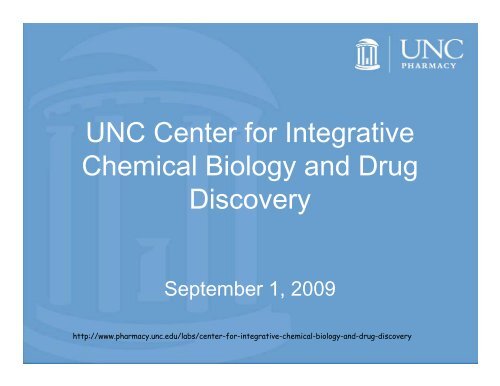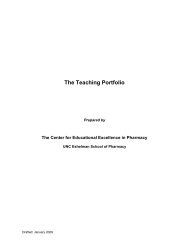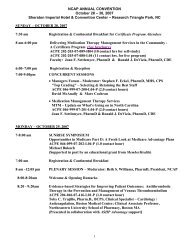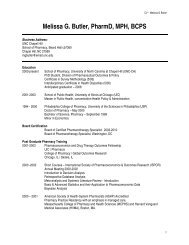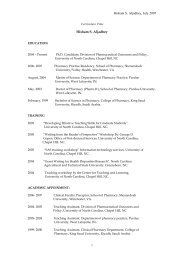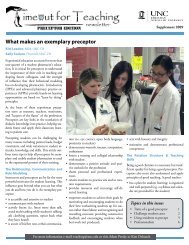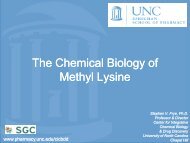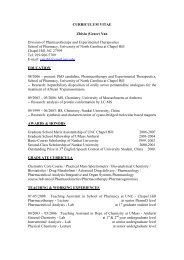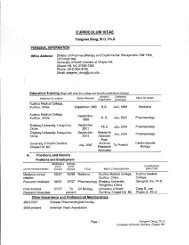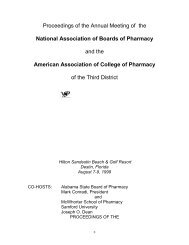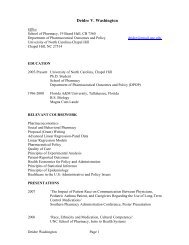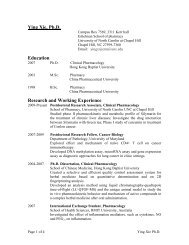UNC Center for Integrative Chemical Biology and Drug Discovery
UNC Center for Integrative Chemical Biology and Drug Discovery
UNC Center for Integrative Chemical Biology and Drug Discovery
Create successful ePaper yourself
Turn your PDF publications into a flip-book with our unique Google optimized e-Paper software.
<strong>UNC</strong> <strong>Center</strong> <strong>for</strong> <strong>Integrative</strong><br />
<strong>Chemical</strong> <strong>Biology</strong> <strong>and</strong> <strong>Drug</strong><br />
<strong>Discovery</strong><br />
September 1, 2009<br />
http://www.pharmacy.unc.edu/labs/center-<strong>for</strong>-integrative-chemical-biology-<strong>and</strong>-drug-discovery
Why Academic <strong>Drug</strong> <strong>Discovery</strong><br />
• Global<br />
– Many diseases are not<br />
adequately addressed<br />
– Underst<strong>and</strong>ing of both<br />
molecular targets <strong>and</strong><br />
disease pathways is<br />
accelerating<br />
• Pharmaceutical <strong>Drug</strong><br />
<strong>Discovery</strong><br />
– Industry’s reputation <strong>and</strong><br />
sustainability in question<br />
– Trend to rely on ‘external’<br />
discovery<br />
– Organizational challenges<br />
as big as the scientific ones<br />
• Biotech<br />
– no more successful per $<br />
spent than majors<br />
– less able to tackle ‘big<br />
problems’<br />
• predictive toxicology<br />
• refinement of HTS –<br />
compounds <strong>and</strong> technology<br />
• Academic <strong>Drug</strong> <strong>Discovery</strong><br />
– a growing enterprise but…<br />
• fit with academic mission<br />
• skill sets missing<br />
• resources limited<br />
– where to focus<br />
<strong>Center</strong> For <strong>Integrative</strong> <strong>Chemical</strong> <strong>Biology</strong> & <strong>Drug</strong> <strong>Discovery</strong><br />
2
<strong>Drug</strong> <strong>Discovery</strong><br />
What can be done better in academia<br />
Target selection –<br />
the disease connection<br />
hypothesis<br />
Current industrial paradigm <strong>for</strong> drug<br />
discovery = A linear process with little<br />
patience <strong>for</strong> deviation<br />
When the target’s role in human<br />
disease is unprecedented,<br />
this rarely works (
<strong>Drug</strong> <strong>Discovery</strong> – what we are trying to do better<br />
at <strong>UNC</strong>.<br />
Target selection –<br />
the disease connection<br />
hypothesis<br />
biology<br />
Small molecule tool<br />
to enhance target<br />
underst<strong>and</strong>ing & validation<br />
<strong>UNC</strong> can excel<br />
at small molecule<br />
driven elucidation of<br />
biology relevant to<br />
<strong>Drug</strong> <strong>Discovery</strong><br />
RESEARCH:<br />
hypothesis generation,<br />
revision & exploration at<br />
the chemistry/biology<br />
interface<br />
chemistry<br />
Efficacy<br />
in treating<br />
disease in<br />
Humans<br />
<strong>Center</strong> For <strong>Integrative</strong> <strong>Chemical</strong> <strong>Biology</strong> & <strong>Drug</strong> <strong>Discovery</strong><br />
4
<strong>Center</strong> <strong>for</strong> <strong>Integrative</strong> <strong>Chemical</strong> <strong>Biology</strong> <strong>and</strong><br />
<strong>Drug</strong> <strong>Discovery</strong><br />
Vision: The <strong>Center</strong> will be an innovative <strong>and</strong><br />
sustainable scientific <strong>for</strong>ce in the creation of new<br />
small molecule therapeutics to improve public<br />
health, to trans<strong>for</strong>m the drug discovery paradigm<br />
<strong>and</strong> to place <strong>UNC</strong> at the <strong>for</strong>efront of translational<br />
medicine.<br />
<strong>Center</strong> For <strong>Integrative</strong> <strong>Chemical</strong> <strong>Biology</strong> & <strong>Drug</strong> <strong>Discovery</strong><br />
5
National Cancer Institute<br />
Comprehensive <strong>Chemical</strong> <strong>Biology</strong> Screening <strong>Center</strong><br />
<strong>UNC</strong><br />
Stephen Frye, Principal Investigator<br />
William Janzen, Assay Development<br />
Dmitri Kireev, Computational Chemistry<br />
Norm Sharpless, Mouse Phase 1<br />
Russ Mumper, <strong>Drug</strong> Delivery<br />
NCCU-BRITE<br />
Li-An Yeh, Director<br />
Gordon Ibeanu, Assay Development<br />
John Scott, Screening<br />
Alfred Williams, Medicinal Chemistry<br />
HAMNER INSTITUTES<br />
Darol Dodd, Toxicology &<br />
Preclinical Studies<br />
Sheela Sharma, Senior<br />
Investigator<br />
<strong>Center</strong> For <strong>Integrative</strong> <strong>Chemical</strong> <strong>Biology</strong> & <strong>Drug</strong> <strong>Discovery</strong><br />
6
CICBDD mission<br />
Target Proposals<br />
from<br />
<strong>UNC</strong> Faculty<br />
“responsive hit<br />
to lead<br />
collaborations”<br />
<strong>Center</strong><br />
Initiated<br />
Projects in<br />
<strong>Chemical</strong><br />
<strong>Biology</strong><br />
“prospective<br />
science”<br />
small molecule ‘probes’<br />
new target DISCOVERY<br />
drug leads<br />
<strong>Center</strong> For <strong>Integrative</strong> <strong>Chemical</strong> <strong>Biology</strong> & <strong>Drug</strong> <strong>Discovery</strong><br />
7
Sample Responsive Projects<br />
• mer kinase inhibitor <strong>for</strong><br />
treatment of acute<br />
lymphoblastic leukemia in<br />
children<br />
(Earp/Johnson/Graham)<br />
• PAP in neuropathic pain<br />
(Zylka)<br />
• ROR2 kinase inhibitors <strong>for</strong><br />
treatment of renal cell<br />
carcinoma (Rathmell)<br />
• Oxytocin agonists <strong>for</strong> social<br />
attachment (Jarstfer)<br />
• Kinase Biosensors (Hahn)<br />
• Breast Cancer Stem Cell<br />
selective cytotoxics (Perou)<br />
• IDH1 mutations in<br />
glioblastoma (Mumper, Xiong)<br />
• DNMT3b inhibitor <strong>for</strong> treatment<br />
of basal-like breast cancer<br />
(Coleman)<br />
• GPCR Functional Selectivity<br />
– atypical antipsychotics<br />
(Roth)<br />
• RGS modulators (Siderovski)<br />
<strong>Center</strong> For <strong>Integrative</strong> <strong>Chemical</strong> <strong>Biology</strong> & <strong>Drug</strong> <strong>Discovery</strong><br />
8
Prospective Science: chemical biology of chromatin<br />
regulation<br />
• Goal: Cell penetrant, small<br />
molecule, quality chemical<br />
probes that modulate the<br />
regulation of chromatin state.<br />
• Approach: A systematic <strong>and</strong><br />
therapeutically unbiased ef<strong>for</strong>t<br />
focused on the writers, readers<br />
<strong>and</strong> erasers of the histone<br />
code.<br />
– tractable intervention points –<br />
enzymes <strong>and</strong> binding domains<br />
with attractive pockets<br />
<strong>Center</strong> For <strong>Integrative</strong> <strong>Chemical</strong> <strong>Biology</strong> & <strong>Drug</strong> <strong>Discovery</strong><br />
9
<strong>Chemical</strong> <strong>Biology</strong> of Epigenetics<br />
DNA<br />
methylation<br />
DNA<br />
Lysine<br />
Histone<br />
Histone<br />
modification<br />
Modification Write Read Erase<br />
Acetyl (Ac) HAT Bromo HDAC<br />
Methyl (Me n<br />
) KMT Royal KDM<br />
<strong>Center</strong> For <strong>Integrative</strong> <strong>Chemical</strong> <strong>Biology</strong> & <strong>Drug</strong> <strong>Discovery</strong><br />
10
MBT Domain Methyl Lysine Recognition<br />
Antagonists: Target Class Project Plan<br />
- biology<br />
- assays<br />
- chemistry<br />
- functional significance<br />
<strong>Center</strong> For <strong>Integrative</strong> <strong>Chemical</strong> <strong>Biology</strong> & <strong>Drug</strong> <strong>Discovery</strong>
Maligant Brain Tumor (MBT) Domain Proteins<br />
Repeats of ~100 aa<br />
Bind lower methylation<br />
states of lysine (KMe1/KMe2)<br />
Act as chromatin locks<br />
11 human & 5 Drosophila<br />
MBTs known<br />
Unique binding cavity<br />
offers<br />
opportunity <strong>for</strong> selective<br />
chemical probes<br />
no known chemical probes<br />
or HTS-compatible assays<br />
<strong>Center</strong> For <strong>Integrative</strong> <strong>Chemical</strong> <strong>Biology</strong> & <strong>Drug</strong> <strong>Discovery</strong><br />
12
Established Low-Throughput Assays <strong>for</strong> MBT Protein Binding<br />
100 µM L3MBTL1 would<br />
be required <strong>for</strong> a screeningworthy<br />
signal!<br />
8 wells = ~ 1 mg protein!<br />
Isothermal titration calorimetry (ITC) has also been employed<br />
ITC also uses 70 – 100 µM protein<br />
Li, Fischle, Wang, Duncan, Liang, Murakami‐Ishibe, Allis & Patel. Molecular Cell 28. 2007, 677<br />
Klymenko, Papp, Fischle, Kocher, Schelder, Fritsch, Wild, Wilm & Muller. 2006 Genes Dev. 20, 1110‐1122<br />
<strong>Center</strong> For <strong>Integrative</strong> <strong>Chemical</strong> <strong>Biology</strong> & <strong>Drug</strong> <strong>Discovery</strong><br />
13
AlphaScreen Assay <strong>for</strong> MBT Antagonists<br />
<strong>Center</strong> For <strong>Integrative</strong> <strong>Chemical</strong> <strong>Biology</strong> & <strong>Drug</strong> <strong>Discovery</strong><br />
14
Buffer Optimization:<br />
Reduction of Non-Specific Binding<br />
Factorial Experimental<br />
Design <strong>for</strong> the Selection of<br />
Agents to Reduce Non-<br />
Specific Binding<br />
NaCl<br />
0 or 50 mM<br />
Tween 2 0 or 0.1 %<br />
BSA 0 or 0.1 %<br />
Large additive effect Small positive intx<br />
negative intx<br />
+ Tween + BSA<br />
–BSA<br />
–BSA<br />
+ BSA<br />
–Tween<br />
NaCl (mM) NaCl (mM) Tween 20 (%)<br />
<strong>Center</strong> For <strong>Integrative</strong> <strong>Chemical</strong> <strong>Biology</strong> & <strong>Drug</strong> <strong>Discovery</strong><br />
15
Optimized Binding Signal<br />
Binding K d<br />
in the nanomolar range –compare to 25 µM <strong>for</strong> the cognate peptide<br />
<strong>Center</strong> For <strong>Integrative</strong> <strong>Chemical</strong> <strong>Biology</strong> & <strong>Drug</strong> <strong>Discovery</strong><br />
16
Competition with Cognate & Non-Cognate<br />
Peptides<br />
Measured IC 50 <strong>for</strong> H3K9Me1 is 22 ± 3 µM M is in agreement with the literature K d<br />
of 2<br />
<strong>Center</strong> For <strong>Integrative</strong> <strong>Chemical</strong> <strong>Biology</strong> & <strong>Drug</strong> <strong>Discovery</strong><br />
17
Assay Validation<br />
<strong>Center</strong> For <strong>Integrative</strong> <strong>Chemical</strong> <strong>Biology</strong> & <strong>Drug</strong> <strong>Discovery</strong><br />
18
LOPAC vs. L3MBTL1 & CounterScreen<br />
LOPAC vs. L3MBTL1<br />
LOPAC vs. AlphaScreen<br />
<strong>Center</strong> For <strong>Integrative</strong> <strong>Chemical</strong> <strong>Biology</strong> & <strong>Drug</strong> <strong>Discovery</strong><br />
19
L3MBTL1 LOPAC Hits by Reductive Analysis<br />
***2 confirmed nanomolar hits***<br />
<strong>Center</strong> For <strong>Integrative</strong> <strong>Chemical</strong> <strong>Biology</strong> & <strong>Drug</strong> <strong>Discovery</strong><br />
20
Functional assay: MBT localization<br />
MBT proteins co-localize with chromatin.<br />
GFP-SFMBT fusion co-localizes with DAPI<br />
staining, while GFP alone (GFP-null) is dispersed<br />
throughout the cell (adapted from Wu et al.,<br />
2007).<br />
<strong>Center</strong> For <strong>Integrative</strong> <strong>Chemical</strong> <strong>Biology</strong> & <strong>Drug</strong> <strong>Discovery</strong><br />
21
FAIRE – genome-wide, hypothesis free, proximal<br />
to target - derepression<br />
©2007 by Cold Spring Harbor Laboratory Press<br />
Giresi P. G. et.al. Genome Res. 2007;17:877-885<br />
<strong>Center</strong> For <strong>Integrative</strong> <strong>Chemical</strong> <strong>Biology</strong> & <strong>Drug</strong> <strong>Discovery</strong><br />
22
What is a quality chemical probe<br />
• CICBDD definition – a compound with sufficient potency <strong>and</strong> selectivity<br />
data to associate its in vitro profile with confidence to its in vivo profile.<br />
– broad in vitro profiling usually desirable<br />
• AlphaScreen <strong>for</strong> 11 human <strong>and</strong> 5 Drosophila MBTs + ΔTm -vs- other<br />
EpiG targets at SGC + CEREP<br />
– mechanism of action versus target is understood<br />
• X-ray co-crystallization (SGC) + binding assay kinetics – whole<br />
nucleosomes<br />
– some hypothesis ‘free’ profiling technique supports designation<br />
• FAIRE<br />
– profiling in vivo includes confirmation of mechanism<br />
• derepression + nuclear localization<br />
– phenotypic data in at least one system is consistent with anticipated effects<br />
• TBD<br />
<strong>Center</strong> For <strong>Integrative</strong> <strong>Chemical</strong> <strong>Biology</strong> & <strong>Drug</strong> <strong>Discovery</strong><br />
23
Chemistry Background <strong>and</strong> Structural <strong>Biology</strong><br />
MBT domains recognize methylated<br />
lysine residues on histone tails <strong>and</strong><br />
their binding interaction leads to<br />
chromatin compaction <strong>and</strong> a<br />
repressed state of the chromatin.<br />
Binding cavity is lined with aromatic<br />
residues allowing <strong>for</strong> a π-cation<br />
interaction with the charged amine.<br />
Further interactions between the MBT<br />
surface <strong>and</strong> residues neighboring the<br />
lysine.<br />
<strong>Center</strong> For <strong>Integrative</strong> <strong>Chemical</strong> <strong>Biology</strong> & <strong>Drug</strong> <strong>Discovery</strong><br />
24
Chemistry Goal <strong>and</strong> Strategy<br />
Goal:<br />
- Development of potent <strong>and</strong> selective<br />
small molecule probes disrupting the<br />
interaction between MBT domains <strong>and</strong><br />
methylated lysine-residues (KMe1,2) in<br />
histone tails.<br />
- Evaluation of the biochemical <strong>and</strong><br />
phenotypic consequences of blocking<br />
recruitment of MBT domain containing<br />
proteins & complexes to chromatin<br />
Strategy:<br />
-There are NO known non-peptide<br />
binders to MBT domains.<br />
- Hypothesis: Disrupt the binding of<br />
MBT domains with methylated lysine<br />
mimetics.<br />
<strong>Center</strong> For <strong>Integrative</strong> <strong>Chemical</strong> <strong>Biology</strong> & <strong>Drug</strong> <strong>Discovery</strong><br />
25
Virtual Screening Method<br />
3D Pharmacophore Screening<br />
• Based on the histone binding mode*<br />
– 3 AA <strong>for</strong>m L3MBTL1/H4K20me2 interface<br />
– Pharmacophore includes amine/cation, H-b<br />
acceptor, H-b donor <strong>and</strong> exclusion spheres<br />
• ChemNavigator<br />
– 5,000,000 Lipinski-filtered compounds<br />
– Enumerated** tautomers <strong>and</strong> stereomers***<br />
– 3D Multicon<strong>for</strong>mer + Energy Minimization**<br />
• Outcome<br />
– 5,000 primary hits<br />
• Clustered <strong>and</strong> visually inspected to skip<br />
abnormal con<strong>for</strong>mers <strong>and</strong> mappings<br />
• 100 representative hits selected <strong>for</strong> structurebased<br />
analysis<br />
• Automated docking<br />
– Constrained cation coordinates<br />
– With Refinement <strong>and</strong> Re-Scoring<br />
• Energy minimization <strong>and</strong> visual inspection of<br />
resulting poses<br />
• 16 representative hits purchased<br />
Dmitri Kireev - CICBDD<br />
*Min, J. et al. Nat. Struct. Mol. Biol. 14, 1229–1230 (2007)<br />
**Using Pipeline Pilot components<br />
***When not explicitly specified<br />
<strong>Center</strong> For <strong>Integrative</strong> <strong>Chemical</strong> <strong>Biology</strong> & <strong>Drug</strong> <strong>Discovery</strong><br />
26
Focused Library Results<br />
<strong>Center</strong> For <strong>Integrative</strong> <strong>Chemical</strong> <strong>Biology</strong> & <strong>Drug</strong> <strong>Discovery</strong><br />
27
Synthetic Chemistry Strategy<br />
Establish a proof of concept<br />
with the preparation of<br />
peptidomimetics using the<br />
natural histone tail sequence<br />
as a template.<br />
• Chemistry ef<strong>for</strong>ts started with nicotinic acid analogs,<br />
• Primary focus on the chain length <strong>and</strong> the amino group.<br />
• Second round of synthetic ef<strong>for</strong>t directed towards aromatic anchor region <strong>and</strong><br />
the linker.<br />
<strong>Center</strong> For <strong>Integrative</strong> <strong>Chemical</strong> <strong>Biology</strong> & <strong>Drug</strong> <strong>Discovery</strong><br />
28
Peptidomimetics<br />
A subsequent docking experiment of<br />
<strong>UNC</strong>00000092A seem to confirme<br />
the additional interaction outside the<br />
binding cavity.<br />
<strong>Center</strong> For <strong>Integrative</strong> <strong>Chemical</strong> <strong>Biology</strong> & <strong>Drug</strong> <strong>Discovery</strong><br />
29
Methylation State<br />
Br<br />
Br<br />
Br<br />
Br<br />
N<br />
N<br />
N<br />
N<br />
O<br />
O<br />
O<br />
O<br />
N<br />
H<br />
N<br />
H<br />
N<br />
H<br />
N<br />
H<br />
NH 2<br />
<strong>UNC</strong>00000091A<br />
H<br />
N<br />
<strong>UNC</strong>00000088A<br />
N<br />
<strong>UNC</strong>00000080A<br />
N +<br />
<strong>UNC</strong>00000093A<br />
Not active<br />
94 ± 9 µM<br />
95 ± 6 µM<br />
Not active<br />
MBTs are selective <strong>for</strong> the methylation<br />
state of the small molecule, but seem<br />
to not differentiate between methyl<strong>and</strong><br />
dimethylamine<br />
Br<br />
Br<br />
Br<br />
N<br />
N<br />
N<br />
O<br />
O<br />
O<br />
N<br />
H<br />
N<br />
H<br />
N<br />
H<br />
N<br />
<strong>UNC</strong>00000147A<br />
N<br />
<strong>UNC</strong>00000087A<br />
N<br />
<strong>UNC</strong>00000150A<br />
47 ± 19 µM<br />
> 100 µM<br />
Not active<br />
Other amino groups are tolerated<br />
within a certain limit, most likely size<br />
O<br />
<strong>Center</strong> For <strong>Integrative</strong> <strong>Chemical</strong> <strong>Biology</strong> & <strong>Drug</strong> <strong>Discovery</strong><br />
30
Aromatic Anchor<br />
• Aromatic Anchor • Linker <strong>and</strong> Chain<br />
Br<br />
N<br />
O<br />
N<br />
H<br />
N<br />
<strong>UNC</strong>00000154A<br />
TBD<br />
Br<br />
N<br />
O<br />
N<br />
H<br />
N<br />
<strong>UNC</strong>00000110A<br />
TBD<br />
Br<br />
H<br />
N<br />
O<br />
H<br />
N<br />
N<br />
<strong>UNC</strong>00000104A<br />
47 ± 19 µM<br />
Br<br />
O<br />
N<br />
>100µM<br />
N<br />
<strong>UNC</strong>00000109A<br />
The aromatic anchor region offers<br />
the most room <strong>for</strong> variation<br />
N<br />
H<br />
N<br />
N<br />
<strong>UNC</strong>00000108A<br />
82 ± 28 µM<br />
<strong>Center</strong> For <strong>Integrative</strong> <strong>Chemical</strong> <strong>Biology</strong> & <strong>Drug</strong> <strong>Discovery</strong><br />
31
target-class synergy<br />
Design <strong>and</strong><br />
synthesize<br />
compounds<br />
knowledge<br />
cycle<br />
Structure determination<br />
-X-ray crystallography<br />
- docking <strong>and</strong> scoring<br />
- interaction analysis<br />
Comprehensive in vitro<br />
<strong>and</strong> in vivo profiling in<br />
biochemical <strong>and</strong> cellular<br />
assays<br />
<strong>Center</strong> For <strong>Integrative</strong> <strong>Chemical</strong> <strong>Biology</strong> & <strong>Drug</strong> <strong>Discovery</strong><br />
32
Assay Enables a Target-Family Profiling<br />
Approach<br />
<strong>Center</strong> For <strong>Integrative</strong> <strong>Chemical</strong> <strong>Biology</strong> & <strong>Drug</strong> <strong>Discovery</strong><br />
33
What is success <strong>for</strong> academic drug discovery<br />
• Creation of new knowledge with direct<br />
therapeutic impact<br />
• Complementary focus to biotech <strong>and</strong> pharma<br />
– orphan indications<br />
– novel targets & target classes<br />
– novel approaches<br />
• Lowering the barrier <strong>for</strong> entry of industrial<br />
science<br />
<strong>Center</strong> For <strong>Integrative</strong> <strong>Chemical</strong> <strong>Biology</strong> & <strong>Drug</strong> <strong>Discovery</strong><br />
34
Acknowledgements<br />
• CICBDD<br />
– Stephen Frye – Director<br />
CICBDD<br />
– Martin Herold –<br />
Postdoctoral Fellow –<br />
medicinal chemistry<br />
– Tim Wigle – Postdoctoral<br />
Fellow – assay<br />
development<br />
– Dmitri Kireev – Director of<br />
Computational <strong>Drug</strong><br />
Design<br />
• <strong>UNC</strong> administration<br />
– Holden Thorpe<br />
– Bob Blouin<br />
– Alex Tropsha<br />
• SGC<br />
– Cheryl Arrowsmith<br />
– Jinrong Min<br />
– Aled Edwards<br />
– Peter Brown<br />
– Masoud Vedadi<br />
– Natalie Nady<br />
<strong>Center</strong> For <strong>Integrative</strong> <strong>Chemical</strong> <strong>Biology</strong> & <strong>Drug</strong> <strong>Discovery</strong><br />
35
CICBDD Team<br />
<strong>Center</strong> For <strong>Integrative</strong> <strong>Chemical</strong> <strong>Biology</strong> & <strong>Drug</strong> <strong>Discovery</strong><br />
36


